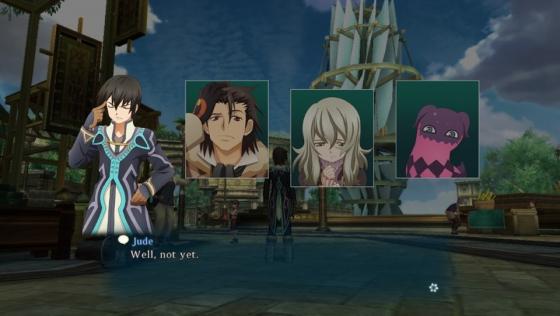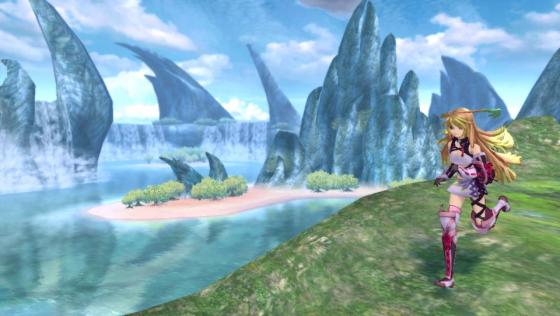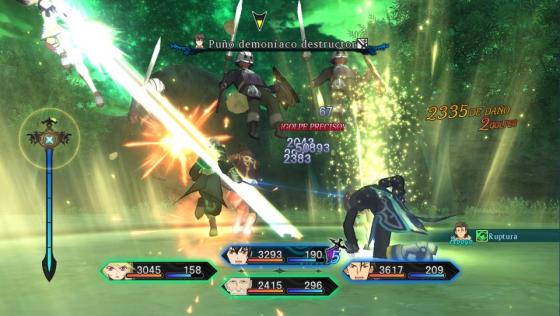
TheSixthAxis
 6th August 2013
6th August 2013
Author: Aran Suddi
Publisher: namco
Machine: PlayStation 3 (US Version)
Tales Of Xillia
Tales Of Xillia isn't a new title. In fact the thirteenth main entry to the Tales franchise released in Japan almost two years ago, but it is only now that Western audiences will finally get the chance to play this JRPG after quite a lot of localisation work, with English voiceovers to the fore.
The story of Xillia follows a medical student named Jude and a mysterious woman named Milla, whose paths cross during the prologue of the game. Interestingly, you can choose which character you want to control before the start of the game, and though the core story is the same regardless of your choice, there are points in the game where the pair are split up, experiencing different events.
The story itself is well paced, though it doesn't stray too far from genre staples of war, magic and discovery. However, it is told in a really pleasant fashion, with much of the information being presented outside of cutscenes. Instead quite a lot of plot points and character development occur while traversing the world map.
As you wander around a small prompt will appear in the corner of the screen suggesting that you press the Select button, which takes you to a screen of character portraits. Here the characters that are involved in the exchange will talk to each other and teach each other things, and they will also talk of their pasts, motivations and events of the main story. This approach makes the relationships between characters feel much more sincere, as it gives the impression that they just speak to each other naturally while travelling. A lot of incidental dialogue can crop up when wandering through the world.The characters themselves also have quite a lot of depth to them, once you get past their physical appearances, such a Milla being dressed with not much clothing. Out of the group there was only one character that annoyed me, but even they eventually grew on me. To have such a breadth of characters who relate well to each other, speaks of how Xillia is crafted as a whole.
Though there are side missions which you can tackle, Tales Of Xillia does nudge you along the main story's path. This is done in a couple of ways, such as not allowing you to leave an area until a story specific event has been completed, or putting a side quest's completion point in a place further along the main quest's path.
You're not forced to hurry, and you can explore each town hub at your leisure, it's just that you're not in one place for too long before moving on to another location. Then again, this does fit the narrative and the urgency of the mission you are tasked with, and you can generally fast travel around the world to clear up any side quests left behind, though the option isn't always available.Visually, the world has the stylings of anime, with a lot of colour around to highlight the different locations, from grassy fields to dark caves. Everything looks well polished, and you can tell a lot of care has gone into the presentation. It feels alive, with beasts wandering around the world, and in the cities, the general murmur of conversation adding to the atmosphere. The soundtrack also does a great job matching the music to the various areas.
The localised character voices are very well acted, expanding on the depth discussed earlier. There is a wide range of emotions displayed from joy to sadness, and it never feels like the actors just said their lines and walked away. It's all very genuine, helping to immerse you into the game world. The only time the talking can get annoying is when characters keep repeating themselves in battle. The game's anime stylings shine throughout.
The battle system itself is was quite surprising to me. This is not a turn based system, but instead much more free flowing, allowing you to run around and attack your various targets, mixing physical and arte (magic) attacks in real time. These are reliant on the character's Assault Counter (AC) and Technical Points (TP) respectively, which will need managing, as only AC will recover after battle, unless you have certain skills unlocked.On the main map avoiding battles is easy too; all you have to do is stay away from an enemy to not engage with them. You can gain an advantage by sneaking behind enemy groups to inflict bonus damage at the beginning of a fight, but enemies can do the same to you, so if you're not aware of your surroundings you could end up in a pretty challenging battle.
Battles allow up to four party members to be present on screen, working together to take out enemies. The option to tweak the strategies involved in combat is also accessible during the campaign, allowing you to build a team ready to face the different challenges that Xillia throws at you.
Sorting out strategies is definitely something you have to do when it comes to boss battles too, with the wrong strategy or party make up leaving you with the defeat screen. Though a nice feature with boss battles, should you fail, was giving you the option to play around with your strategies, equipment and characters and try again, or load an earlier save.One key strategy in battle is linking, where two characters can partner up to help each other. It's easy to use, with the character stat bars arranged in a diamond shape on screen, and just needing you to press the corresponding directions on the D-Pad. These linked powers range from keeping enemies away, to double-teaming an enemy with quick attacks. Put together enough hits and the option for a charged attack appears, allowing a much more powerful and damaging hit to be unleashed on the intended target. Combat merges physical attacks with magic and multi-character attacks.
The one problem I had with the battle system lay in the targeting and attack execution itself. The majority of the time the battles would play out fine, but occasionally, the character I was in control of would begin an attack and move in completely the wrong direction. It was frustrating to watch these attacks unfold without being able to stop them, but thankfully it didn't happen often enough that it interfered.
The AI is very good though; party members will follow your strategies and come to your aid when needed, without much input from yourself. To counter the good companion AI, the enemy is also quite smart, and will adjust their tactics through the battle, in an attempt to weaken the party. For example, it will sometimes attack the most powerful of the group, or other times the healer.So, while most battles can be done in a short amount of time, especially against the lower level types, once the higher levels enemies appear, you have to be ready for anything.
As well as equipping different artes and equipment, characters can also have different skills which give additional advantages during battles. They are unlocked by gaining experiencing, and leveling up through something called the Lillium Orb.
Within Xillia's world the Lillium Orb is an object that most adventurers have, which gives them advantages in battles. The presentation of the system is designed to look like a spider's web, with nodes dotted around the web. Each node belongs to a category, which affects the characters base stats, such as Strength, Vitality or Psyche.As these nodes are unlocked through experience new skills are discovered, and can be assigned as long as characters have enough Skill Points. Much thought is needed when assigning skills, especially early on. However as you level up more skills can be equipped making the characters stronger.
Leveling up the stats isn't the only way characters get stronger; gaining access to new weapons, armour and accessories is also a major part of success. Tales Of Xillia has a brilliant shop system implemented, where instead of different armour or weapon stores selling different items, they all stock the same things.
The best items aren't available to purchase early on, and you have to invest in the shops to level them up, by donating either materials or gald, the in game currency. Personally I leveled up using materials I found in the world, and discovered that each store gains more experience if you give them certain items. Then, as stores level up, they have access to more goods to sell the player.
This system doesn't only encourage you to explore the world to find materials to donate, but it also makes it easier to sell off old equipment. The store shows whether an item is advantageous or detrimental to your character's stats with the simple display of an arrow pointing up or down. You'll quickly enter a cycle of trading in old weapons and armour for better ones, without keeping hold of anything you don't need.
Good Points
- The game's art style and music is fantastic.
- The characters and story have a nice depth to them.
- The shop leveling system is great.
- Save system is very generous.
Bad Points
- On rare occasions characters will not act correctly in battle.
Verdict
Tales Of Xillia is a brilliant title, and could just be the breakout game that really establishes the series in Western markets. There's a great story here, with likable characters and voice acting that makes the characters feel real. The streamlined leveling, equipment choices and skill tree make Xillia one of the best RPGs I've played. In fact Tales Of Xillia may just be what the JRPG genre needed.
Other PlayStation 3 Game Reviews By Aran Suddi
Scores
PlayStation 3 Version| Overall | 100% |















